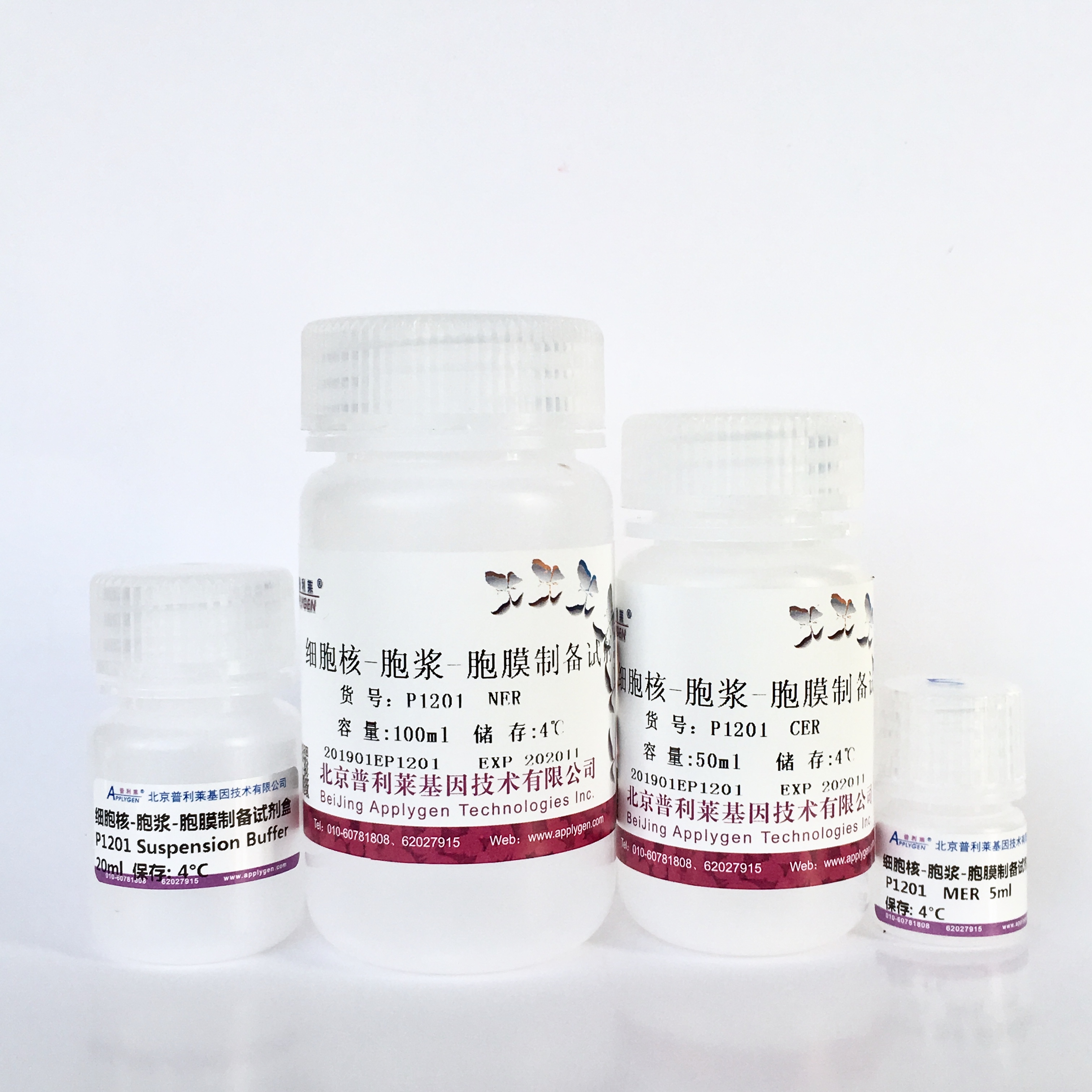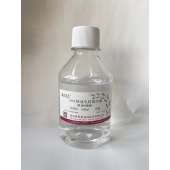细胞核-胞浆蛋白-胞膜制备试剂盒 Nucl-Cyto-Mem Preparation Kit P1201厂家直销,提供OEM定制服务!
- 产品详情
- 说明书下载
- 引用文献
描述:本试剂盒能够从哺乳动物新鲜或冻存的组织块、贴壁或悬浮细胞中制备细胞核、细胞膜与胞内质膜、细胞浆等三种主要亚细胞组分。其独特的试剂成分与优化的制备方案使胞核-胞浆-胞膜制备过程简单易行,无需特殊设备和超速离心,可在1小时内完成。应用本试剂盒制备的胞膜是细胞膜和细胞器膜如线粒体、内质网及质膜的混合物,得到的细胞核是完整的未裂解细胞核,胞浆组分为可溶性胞浆蛋白。制备得到的产物纯度可胜任后续的免疫沉淀、蛋白印迹、2-D gel、酶活性检测和受体分析等实验。
组成:(以下是50次规格用量)
CER (Cytosol Extraction Reagent) 25ml
MER (Membran Extraction Reagent) 2.5ml
NER (NuclearExtractionReagent) 50ml Suspension Buffer 10m
储存:各组分4oC 有效期12个月
规格:50次 100次
操作步骤:
一.样本预处理:
收集细胞:(在每一次制备过程中,使用等量的细胞数将明显提高后续检测结果的一致性,因此建议在制备前对细胞准确计数)
1. 贴壁细胞:用PBS缓冲液冲洗细胞平皿,用胰蛋白酶消化细胞。800g离心5-10分钟,弃上清,用PBS缓冲液重悬洗涤细胞并再次离心收集细胞。
2. 悬浮细胞:800g离心5-10分钟,弃上清。用PBS缓冲液重悬洗涤细胞并再次离心收集细胞。
以下制备过程要在4oC或冰水浴中进行
二.组织细胞匀浆裂解
1.细胞匀浆裂解:
向每1x107个细胞或每100µl(细胞离心后的体积)细胞沉淀中加入500µlCER试剂,震荡重悬,冰浴2分钟。将细胞悬液转移到冰预冷的玻璃匀浆器内,在冰水浴中上下手动匀浆20-30次。
注意:此破碎细胞步骤为关键环节。要使用1-3ml小容积玻璃匀浆器,须选用间隙严密的研杵,其特征是将研杵插入匀浆器套管后,可提起研杵而套管不会脱落。有效研磨是上下推拉而不是旋转。破碎效果与细胞类型有关,可在相差显微镜下检查,未裂解细胞应小于5%。
2.组织块匀浆裂解:
取250mg哺乳动物新鲜或-80oC冻存组织块放入冰预冷的玻璃匀浆器内,加入500µlCER试剂。用研杵捣碎组织块,上下手动匀浆20次,冰浴10分钟,然后上下手动匀浆7次。
注意:与培养细胞特别是贴壁细胞相比,组织块中的细胞在匀浆时较易破碎,因而并非必须选择间隙严密的研杵。如果研杵与套管过于严密,会使组织匀浆困难,可选用研杵与套管稍松的匀浆器,破碎效果与组织细胞类型有关,可在相差显微镜下检查,未裂解细胞应少于5%。
三.粗提物制备:
取约500µl裂解物,转移到新的离心管中,800g ,4oC离心5分钟。此时,细胞核的粗制品沉淀在管底,上清为胞膜-胞浆混合物。
四.胞膜胞浆制备:
1)将步骤三获得的上清转移到新的离心管中,估计上清的体积;2)加入上清液1/10体积的MER与上清液混合,冰浴5分钟;3)14,000rpm,4oC离心30分钟;4)取上清液转移到新离心管中,此为胞浆组分;5)沉淀为胞膜组分,含有细胞膜和亚细胞器碎片,可短暂离心除尽液体,用50-100µl Suspension Buffer 或自备溶液重悬胞膜。
五.细胞核制备:
1)向步骤三中获得的细胞核粗提物中加入500µl NER,震荡重悬;2)4,000g,4oC离心5分钟,弃上清;3)再次加入500µl NER洗涤细胞核沉淀,重复上述离心步骤,离心后的上清应为清亮; 4)弃上清,除尽液体。用50-100µlSuspension Buffer重悬细胞核,得到完整和没有破碎的细胞核。用户也可以使用自备溶液如SDS上样缓冲液直接裂解细胞核。
说明:
1.Suspension Buffer 不含去垢剂,重悬于Suspension Buffer 中的胞膜或胞核组分呈不溶解状态是正常的,用户可用自备溶液重悬胞膜或胞核成分。如果进行蛋白印迹、2-Dget等实验,用户可用SDS上样缓冲直接裂解细胞膜或细胞核成分。对于进行免疫共沉淀实验来说,可用RIPA裂解液(C1053)重悬胞膜或胞核组分。
2.胞浆组分可直接进行蛋白定量。纯的胞膜和胞核蛋白浓度很低,但与胞浆蛋白浓度成比例,因而不需要单独定量,如需定量可加入TritonX-100至终浓度1%或SDS至终浓度0.5%用BCA法蛋白定量。
3.用SDS-PAGE Loading 缓冲液裂解细胞核后,DNA释放会使核裂解物十分粘稠,可95oC加热5分钟,高速震荡打断DNA,重复加热2-3次。
4.如果进行凝胶阻滞(EMSA)实验,建议使用普利莱P1200产品,该试剂盒可直接提取可溶性核蛋白.
5.试剂盒各组分中未添加蛋白酶抑制剂,用户可自行选择添加,通常4oC快速操作不加蛋白酶抑制剂不会出现问题。
6.沉淀胞浆蛋白方法:估算胞浆蛋白组分的体积,加入1/3体积30%三氯醋酸水溶液,-20oC沉淀1小时或过夜。5,000g,4oC离心10分钟,弃上清,空气略干沉淀。用1xSDS上样缓冲液溶解沉淀,95oC加热5分钟,上样电泳。
以下仅列举数篇使用普利莱P1201试剂盒发表的文章供参考。
1、
1. Zhang X, Lin Y, Lin S, et al. Silencing of functional p53 attenuates NAFLD by promoting HMGB1-related autophagy induction[J]. Hepatology International, 2020, 14: 828-841.
2. Zhang Z, Liu H, Zhao Z, et al. GJ-4 alleviates Aβ25-35-induced memory dysfunction in mice through protecting the neurovascular unit[J]. Biomedicine & Pharmacotherapy, 2020, 127: 110131.
3. Wang J, Chen Y, Pan R, et al. Leukocyte cell‐derived chemotaxin 2 promotes the development of nonalcoholic fatty liver disease through STAT‐1 pathway in mice[J]. Liver International, 2021, 41(4): 777-787.
4. Zheng J, Jiang Y Y, Xu L C, et al. Adult hippocampal neurogenesis along the dorsoventral axis contributes differentially to environmental enrichment combined with voluntary exercise in alleviating chronic inflammatory pain in mice[J]. Journal of Neuroscience, 2017, 37(15): 4145-4157.
5. Song Z, Xiong B, Guan X, et al. Minocycline attenuates bone cancer pain in rats by inhibiting NF-κB in spinal astrocytes[J]. Acta PharmacologicaSinica, 2016, 37(6): 753-762.
6. Tian J, Song T, Wang H, et al. Thalidomide alleviates bone cancer pain by down-regulating expressions of NF-κB and GFAP in spinal astrocytes in a mouse model[J]. International Journal of Neuroscience, 2019, 129(9): 896-903.
7. Yuan Y, Zhao X, Wang P, et al. PTENα regulates endocytosis and modulates olfactory function[J]. The FASEB Journal, 2019, 33(10): 11148-11162.
8. Zhao Z, Ning J, Bao X, et al. Fecal microbiota transplantation protects rotenone-induced Parkinson’s disease mice via suppressing inflammation mediated by the lipopolysaccharide-TLR4 signaling pathway through the microbiota-gut-brain axis[J]. Microbiome, 2021, 9(1): 1-27.
9. Sun L, Hu L, Li Y, et al. Mesoaccumbens dopamine signaling alteration underlies behavioral transition from tolerance to sensitization to morphine rewarding properties during morphine withdrawal[J]. Brain Structure and Function, 2014, 219: 1755-1771.
10. Zhao Z, Li F, Ning J, et al. Novel compound FLZ alleviates rotenone-induced PD mouse model by suppressing TLR4/MyD88/NF-κB pathway through microbiota–gut–brain axis[J]. Acta Pharmaceutica Sinica B, 2021, 11(9): 2859-2879.
11. He Y, Ye Z Q, Li X, et al. Alpha7 nicotinic acetylcholine receptor activation attenuated intestine-derived acute lung injury[J]. Journal of Surgical Research, 2016, 201(2): 258-265.
12. Yu M, Du H, Wang B, et al. Exogenous H2S induces Hrd1 s-sulfhydration and prevents CD36 translocation via VAMP3 ubiquitylation in diabetic hearts[J]. Aging and disease, 2020, 11(2): 286.
13. Lv B Y, Sun H Y, Li Q, et al. The ameliorating effects of bushentiaoxue granules and kunling wan on impaired angiogenesis and endometrial receptivity in rats following controlled ovarian hyperstimulation[J]. Microcirculation, 2020, 27(1): e12581.
14. Wang W, Liu Z, Chen X, et al. Downregulation of FABP5 suppresses the proliferation and induces the apoptosis of gastric cancer cells through the hippo signaling pathway[J]. DNA and Cell Biology, 2021, 40(8): 1076-1086.
15. Xu S, Wang P, Wei K, et al. Cytoprotection of perfluorocarbon on PMVECs in vitro[J]. Inflammation, 2013, 36: 512-520.
16. Cui H Y, Zhang X J, Yang Y, et al. Rosmarinic acid elicits neuroprotection in ischemic stroke via Nrf2 and heme oxygenase 1 signaling[J]. Neural Regeneration Research, 2018, 13(12): 2119.
17. Wang J, Zhou M, Jin X, et al. Glycochenodeoxycholate induces cell survival and chemoresistance via phosphorylation of STAT3 at Ser727 site in HCC[J]. Journal of cellular physiology, 2020, 235(3): 2557-2568.
18. Wu S, Yue Y, Tian H, et al. Tramiprosate protects neurons against ischemic stroke by disrupting the interaction between PSD95 and nNOS[J]. Neuropharmacology, 2014, 83: 107-117.
19. Zhang Y P, Pan C S, Yan L, et al. Catalpol restores LPS-elicited rat microcirculation disorder by regulation of a network of signaling involving inhibition of TLR-4 and SRC[J]. American Journal of Physiology-Gastrointestinal and Liver Physiology, 2016, 311(6): G1091-G1104.
相关产品

 微信登录
微信登录 收藏本站
收藏本站





